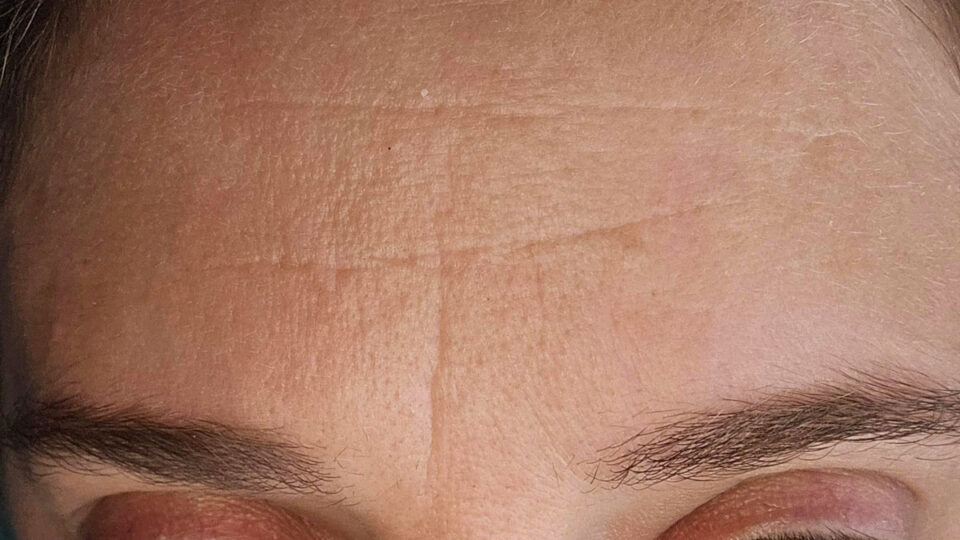Why do Forehead Lines form?
Forehead lines primarily develop due to the following factors:
- Muscle movement: The frontalis muscle, which spans the forehead from the eyebrows to the hairline, raises the eyebrows. Repeated contractions of this muscle over time lead to the formation of horizontal lines.
- Aging process: As we age, our skin loses collagen and elastin, essential proteins that maintain skin firmness and elasticity. This natural decline reduces the skin’s ability to bounce back after facial expressions, contributing to the formation of wrinkles.
- UV exposure: Excessive sun exposure accelerates aging by breaking down collagen, leading to premature wrinkle formation.
- Genetics: Due to their genetic makeup, some individuals are naturally more susceptible to developing facial lines, including those on the forehead.
- Repetitive facial expressions: Frequent eyebrow raising, especially when expressing surprise or concern, can cause lines to become more pronounced over time.
- Lifestyle factors: Smoking reduces blood flow to the skin, depriving it of nutrients and increasing susceptibility to wrinkles. Additionally, a diet high in simple sugars can contribute to the loss of skin elasticity through a process called glycation.
- Environmental factors: Exposure to pollutants and other environmental stressors can accelerate skin aging and wrinkle formation.
The Role of the Frontalis Muscle in Dynamic Wrinkle Creation
The frontalis muscle, a thin, vertically oriented muscle spanning the forehead, is the primary driver of forehead line formation. This muscle contracts to elevate the eyebrows, creating horizontal skin folds during expressions such as surprise, curiosity, or concern.
In youth, the skin’s robust collagen and elastin networks allow it to rebound smoothly after muscle relaxation. However, with repeated contractions over decades, the cumulative mechanical stress induces microtrauma to the dermal matrix. Each contraction generates shear forces that disrupt collagen fibrils and elastin fibers, gradually reducing the skin’s ability to return to its original state.
Transition from Dynamic to Static Wrinkles
Initially, forehead lines appear only during muscle activation (dynamic wrinkles). Around the third decade, the skin’s regenerative capacity declines, and these temporary folds begin leaving residual creases at rest.
This transition to static wrinkles correlates with histopathological changes: cross-sectional studies show a 1-2% annual reduction in dermal collagen density starting at age 25, accelerating to 3-5% per year post-menopause.
The degradation of type I and III collagen, critical for tensile strength, leaves the skin structurally compromised, allowing gravitational forces to deepen existing lines.
What are the best treatments for deep forehead lines?
For deep forehead lines, The Cosmetic Studio Noosa offers several effective treatments:
Genius RF Microneedling
This advanced procedure combines traditional microneedling with radiofrequency energy to address skin concerns, including fine lines and forehead wrinkles.
The treatment delivers controlled heat through micro-needles into precise dermal layers of the skin, stimulating collagen and elastin production. This process helps improve skin texture, reduce the appearance of wrinkles, and tighten the skin.
Beauty Booster
Beauty Booster combines a rejuvenation treatment with vitamins and amino acids to improve skin texture, reduce fine lines, and enhance overall skin quality, making it an excellent treatment option for Forehead lines.
TCA Peels
TCA peels at 20-35% concentrations induce controlled protein denaturation up to the papillary dermis. This eliminates photoaged keratinocytes while upregulating MMP-2 and TIMP-1 to reorganise collagen bundles. Combined with pre-peel retinoid priming, TCA achieves 40-50% wrinkle depth reduction in 1-2 sessions.
Jessner Peel
The blended Jessner formula provides epidermolytic action without requiring neutralisation.
Are you unsure which treatment will suit you best? Our Registered Nurses are here to help! Book a consultation today and start your journey to a newer you.
